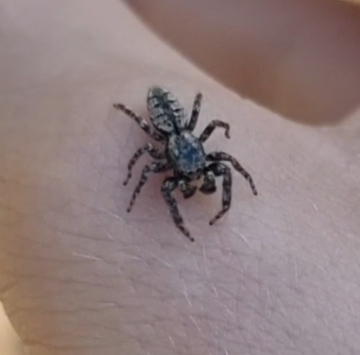Notes on Marpissa muscosa

MARPISSA MUSCOSA (CLERCK) ON DRY STONE WALLS IN DORSET by P. MERRETT
From The Newsletter No. 11 December 1974
As far as I am aware, all past records of Marpissa muscosa in Britain have been from under bark, on tree trunks or posts, or in the crevices of paling fences. While collecting on the limestone grassland near the cliffs west of Swanage on 26th. May, 1974, I was surprised, therefore, to see an immature specimen on one of the dry stone walls which cross this area. Further investigation revealed that the species was abundant under flat stones on the top of all the walls in the vicinity.
In Dorset, dry stone walls are confined to those regions where stone is readily available, i.e. on the Jurassic limestone Purbeck and Portland Beds, and the survey of M. muscosa was later extended to cover all these areas in south-east Dorset. The principal belt of this limestone extends from Worbarrow Bay (Grid ref. SY8780) to Swanage (Grid ref. SZ0378), a distance of about 16 Km, being narrow at its western end, but broadening out in its eastern half to extend about 3 Km inland from the coast, and it is present in 54 1 Km squares. Here M. muscosa has been found on all suitable walls investigated, and has been recorded from a total of 42 1 Km squares, corresponding closely to the distribution of the limestone rocks. It is most numerous in the eastern half of the region where the walls form an extensive inter-connecting system. It was not possible to look at the 4 most westerly 1 Km squares as these lie within the Lulworth military danger area, and a few of the more inaccessible marginal areas have also not yet been searched. M. muscosa occurs mainly under small flat stones lying on other flat stones at the top of the walls, where it spins a retreat in the horizontal crevice between the stones, sometimes several being found under one stone. It appears rarely to venture into the open, and does not occur where the top of the wall is composed of rounded stones which do not provide suitable crevices, or if the wall is cemented at the top. Also if the wall has crumbled to near ground level, Textrix denticulata appears to take over from Marpissa.
It was not found at either of the two smaller areas of Purbeck and Portland Beds examined, at Portland itself and north of Weymouth near Preston (Grid. ref. about SY7085). It is possible that it has not managed to reach Portland, as it is virtually an island; the extensive system of apparently suitable walls there were occupied mainly by T. denticulata, Segestria senoculata and Drassodes lapidosus, which tend to be present in much smaller numbers where M. muscosa is abundant. The band of limestone rocks north of Weymouth is also rather isolated and limited in extent, and there are few suitable walls.
Dahl (1926, p.40) , Simon (1937, p.1207), Locket & Millidge (1951, p.215) and Bristowe (1958, p.158) all describe the habitat of M. muscosa as being tree trunks, posts or fences, on or under bark, but Tullgren (1944, p.46) mentions that it also occurs among loose stones, e.g. on walls, in Sweden. I should be interestsd to hear of any other records of this species on walls in Britain.
References
Bristowe, W.S. (1958). The World of Spiders.
Dahl, F. (1926). Die Tierwelt Deutschlands. Teil 3. Springspinnen.
Locket, G.H. & Millidge, A.F. (1951). British Spiders, Vol. I.
Simon, E. (1937). Les Arachnides de France. Tome 6.
Tullgren, A. (1944). Svensk Spindelfauna. 3. Fam. 1-4.
Added by John Partridge at 11:41 on Tue 3rd Jan 2012.
Return to Summary for Marpissa muscosa